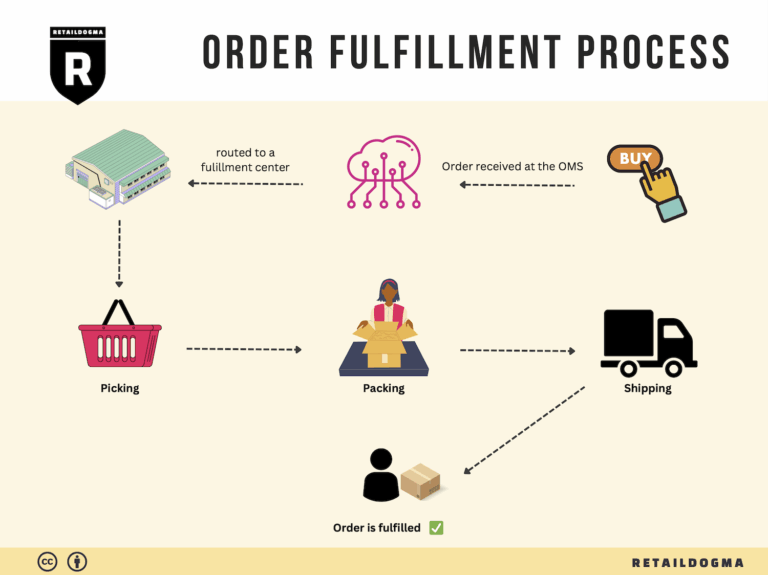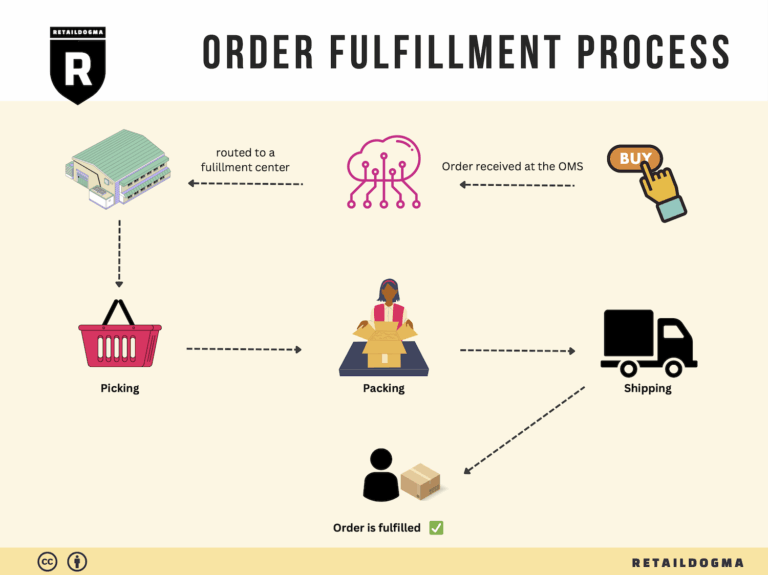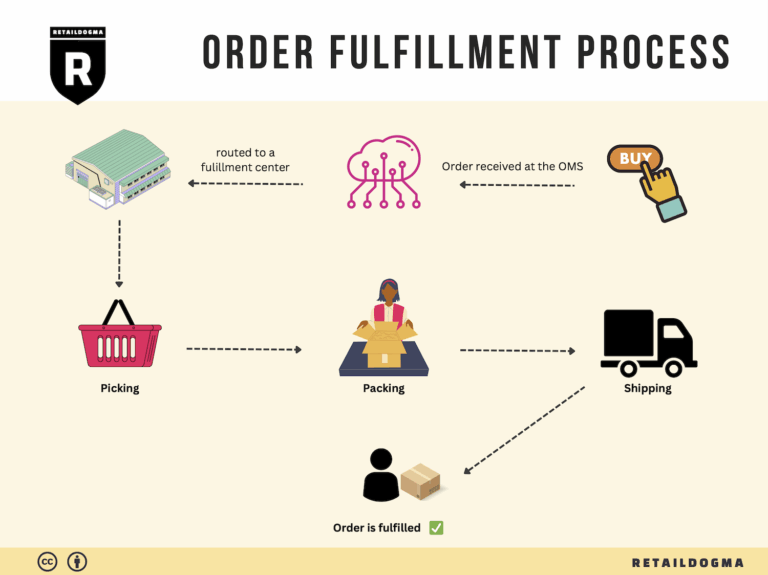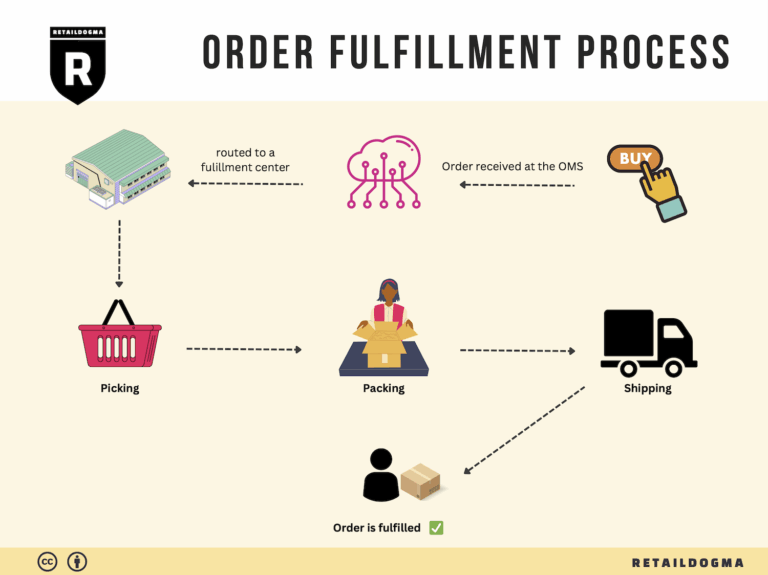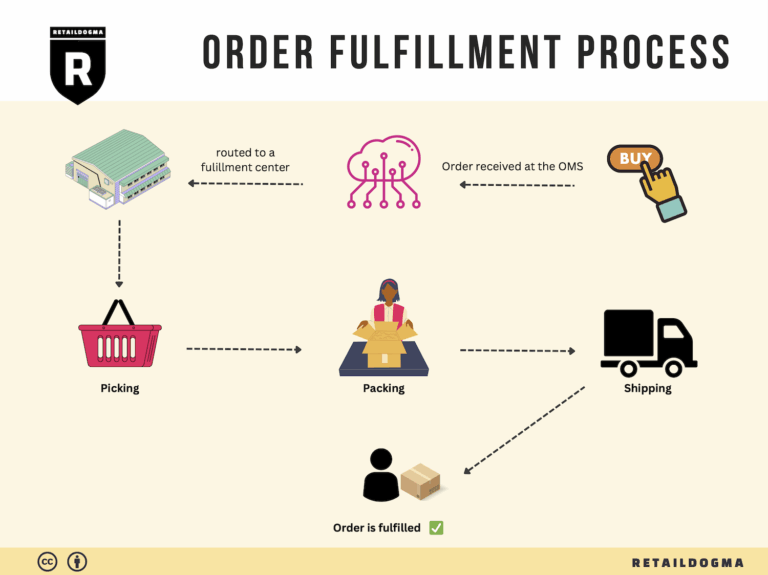How Order Fulfillment Works: A Step-by-Step Guide for Businesses
What is E-commerce Fulfillment? An Introduction for Growing Businesses
Navigating the Complexities of E-commerce Fulfillment
As an e-commerce business owner, you’ve likely experienced the growing pains of packing and shipping orders. What starts as an exciting venture can quickly become overwhelming as your sales increase. Managing logistics, inventory, and customer expectations can consume precious time and resources, diverting your focus from what truly matters—growing your business and engaging with customers. This is where effective e-commerce fulfillment comes into play.
E-commerce fulfillment is the end-to-end process of getting a product from your warehouse to your customer’s doorstep. It encompasses everything from inventory management and order processing to packaging and shipping. For many businesses, especially those scaling rapidly, outsourcing fulfillment to a third-party logistics provider (3PL) or utilizing fulfillment by Amazon (FBA) can streamline operations and optimize costs.
In this guide, we will explore the various fulfillment models available to growing businesses. We will demystify options like 3PL and FBA, highlighting their respective advantages and how they align with different business needs. Understanding these models is crucial in determining the right strategy for your operations.
We will also delve into the core services that fulfillment partners typically offer. This includes warehousing, pick-and-pack services, shipping, and returns management. Knowing what services are available will empower you to choose a partner that can meet your specific operational requirements and customer expectations.
Selecting the right fulfillment partner is a critical decision that can significantly impact your business’s efficiency and customer satisfaction. We will provide practical tips on what to consider when evaluating potential partners, such as their technology capabilities, shipping options, and customer support.
Finally, we will discuss pricing structures commonly used in the fulfillment industry, helping you understand the financial implications of different services and models. By gaining clarity on costs, you can make informed choices that align with your budget and growth objectives.
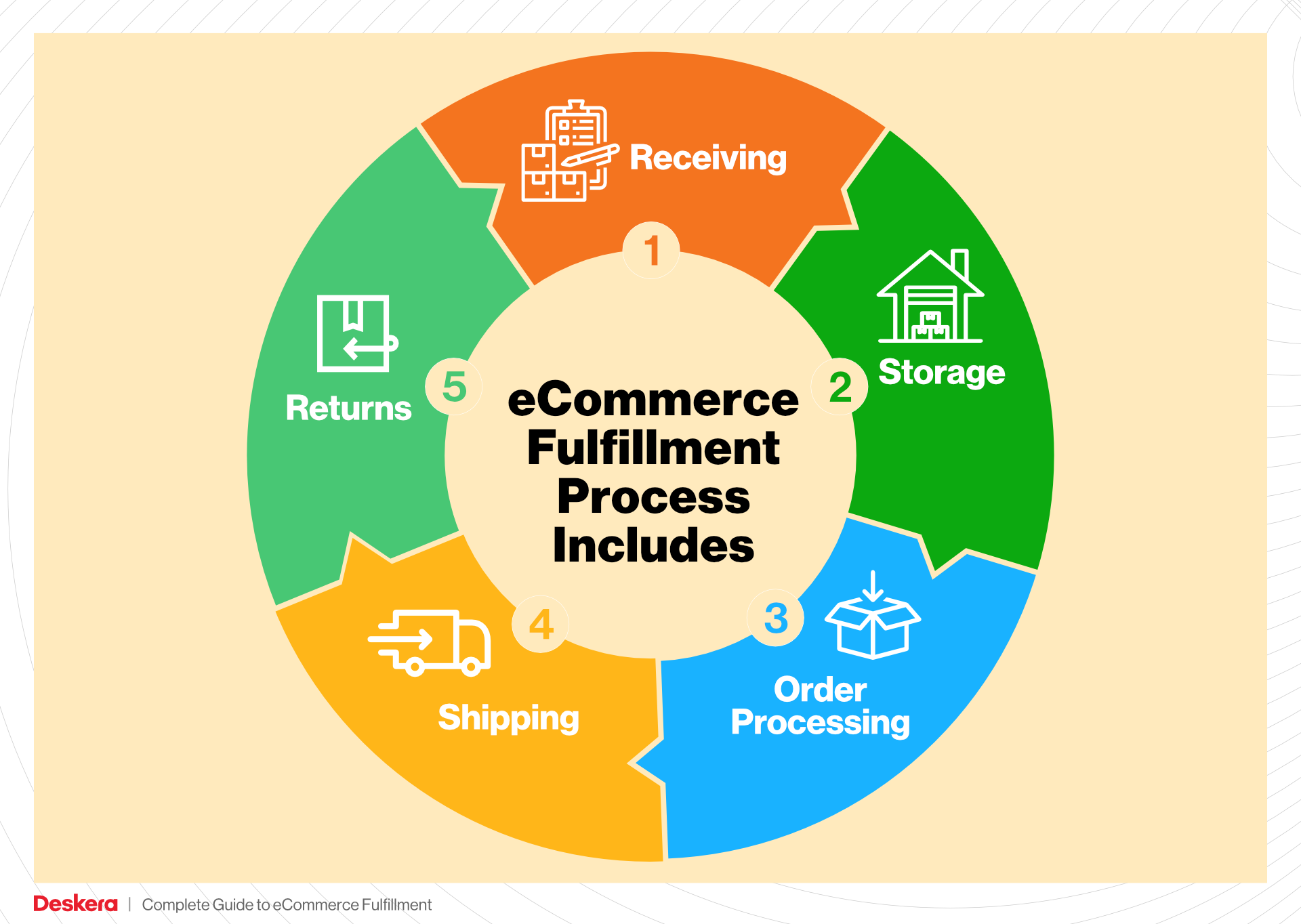
Our goal with this guide is to empower you to make smart, strategic decisions about your logistics. By understanding the fundamentals of e-commerce fulfillment, you can streamline your operations, reduce costs, and enhance customer satisfaction—ultimately positioning your business for sustained growth and success in the competitive online marketplace.
What You’ll Learn In This Guide
- What is E-commerce Fulfillment? An Introduction for Growing Businesses
- The Order Fulfillment Process: From ‘Buy’ Button to Customer’s Door
- Comparing Fulfillment Models: In-House vs. 3PL vs. Dropshipping
- A Deep Dive into Amazon FBA: Pros, Cons, and Who It’s For
- Core Services Offered by Fulfillment Centers
- How to Choose a Fulfillment Partner: A 6-Point Checklist
- Understanding Fulfillment Pricing: A Breakdown of Common Fees
- Frequently Asked Questions (FAQs) about Fulfillment
- Conclusion: Is Outsourcing Fulfillment the Right Move for Your Business?
- Important Disclaimer
The Order Fulfillment Process: From ‘Buy’ Button to Customer’s Door
1. Receiving Inventory
The order fulfillment process begins with the reception of inventory at the warehouse. This step involves checking incoming shipments against purchase orders to ensure accuracy and completeness. Key tasks include inspecting the condition of the products and verifying quantities. This is crucial for maintaining inventory accuracy and preventing stock discrepancies.
An important term associated with this step is SKU (Stock Keeping Unit). Each product should have a unique SKU that allows for easy tracking and management throughout the fulfillment process. Effective inventory management starts here; errors in receiving can lead to stockouts or overstock situations, which can disrupt the entire supply chain. Properly executed receiving processes set the foundation for efficient operations, ensuring that the right products are available for customer orders.
2. Warehouse Storage
Once the inventory is received and verified, it is stored in the warehouse. This step involves organizing products in a systematic manner, utilizing storage solutions such as shelves, bins, or pallets based on product size and demand. Efficient warehouse storage is vital for minimizing retrieval times and optimizing space utilization.
Key terms related to this step include slotting and ABC analysis. Slotting refers to the strategic placement of products in the warehouse based on their sales velocity, while ABC analysis categorizes inventory based on importance and turnover rates. By implementing these strategies, businesses can streamline order picking later in the fulfillment process. Proper storage ensures that items are easily accessible, reducing the time it takes to fulfill orders and ultimately enhancing customer satisfaction.
3. Order Picking
When a customer places an order, the next step is order picking. This process involves selecting the appropriate items from the warehouse to fulfill the order. Order picking can be done using various methods, such as single order picking, batch picking, or zone picking, depending on the volume and complexity of the orders.
A crucial term in this step is pick list, which is a document or digital tool that outlines the items to be picked for each order, along with their locations in the warehouse. Efficient order picking is essential as it directly impacts order accuracy and fulfillment speed. Errors during picking can lead to customer dissatisfaction and increased return rates. By optimizing picking strategies and leveraging technology, businesses can enhance their operational efficiency and improve overall service levels.
4. Order Packing
After items are picked, they move to the packing stage. This step involves securely packaging the selected products for shipment, ensuring that they arrive in perfect condition at the customer’s door. Packing not only protects the items but also involves labeling and documentation, such as invoices and shipping labels.
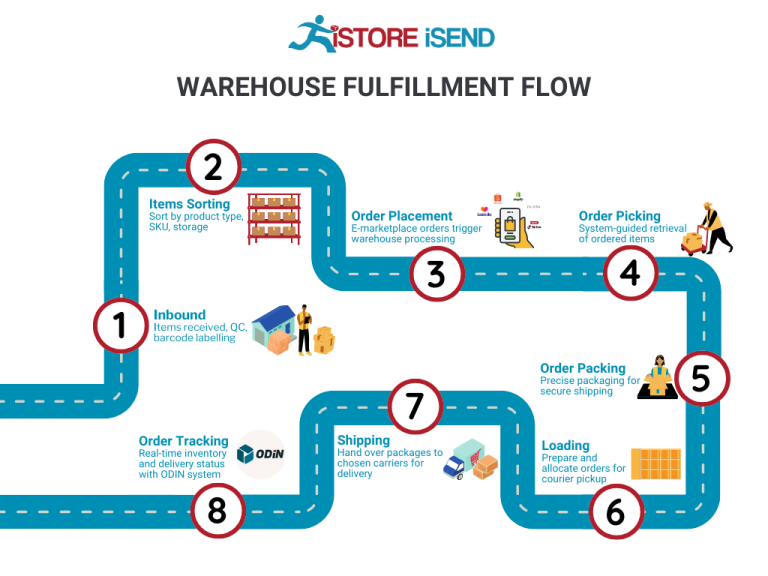
An important term associated with this step is packing slip. This document accompanies the order and outlines the contents, serving as a confirmation for the customer and the shipping carrier. Effective packing processes are essential for reducing damages during transit and ensuring compliance with shipping regulations. Additionally, well-packed orders enhance the unboxing experience for customers, which is increasingly important in today’s e-commerce landscape.
5. Shipping & Delivery
The final step in the order fulfillment process is shipping and delivery. Once the orders are packed, they are handed over to shipping carriers for delivery to the customer. This step includes selecting the appropriate shipping method based on cost, speed, and destination, as well as tracking the shipment until it reaches the customer.
A key term in this step is last-mile delivery, which refers to the final leg of the shipping journey from the distribution center to the customer’s doorstep. This phase is critical because it directly affects customer satisfaction and can often be the most complex and costly part of the shipping process. By optimizing last-mile delivery through technology and efficient carrier partnerships, businesses can reduce shipping costs and improve delivery times, ultimately enhancing the customer experience and fostering repeat business.
In conclusion, understanding and optimizing each step of the order fulfillment process is essential for e-commerce businesses aiming to scale efficiently. By focusing on receiving, storage, picking, packing, and shipping, businesses can ensure a seamless transition from the ‘buy’ button to the customer’s door, ultimately driving growth and customer loyalty.
Comparing Fulfillment Models: In-House vs. 3PL vs. Dropshipping
Fulfillment Model Comparison
| Model | Who Handles Inventory | Best For (Business Stage) | Key Advantage | Key Disadvantage |
|---|---|---|---|---|
| In-House Fulfillment | The business itself | Startups to established | Full control over inventory and processes | High overhead costs and resource demand |
| Third-Party Logistics (3PL) | Third-party provider | Scaling businesses | Cost-effective and scalable solutions | Less control over the fulfillment process |
| Dropshipping | Supplier | Startups or niche markets | Low startup costs and no inventory risk | Lower margins and potential quality issues |
In-House Fulfillment
In-house fulfillment refers to a model where a business manages its own storage, inventory, and shipping processes. This model is often favored by startups and established companies that require complete control over their supply chain. By handling fulfillment internally, businesses can maintain direct oversight of their inventory management, order processing, and shipping operations. This model allows for customization in packaging and branding, which can enhance the customer experience. However, in-house fulfillment comes with significant overhead costs, including warehousing, staffing, and logistics infrastructure. Additionally, as order volumes grow, the demand for resources can strain operations, making it challenging to scale efficiently. Therefore, while in-house fulfillment can provide control and customization, it may not be sustainable for long-term growth without substantial investment.
Third-Party Logistics (3PL)
Third-party logistics (3PL) involves outsourcing logistics and fulfillment functions to a specialized provider, such as Vox Fulfillment. This model is particularly beneficial for businesses looking to scale without the burden of managing logistics in-house. 3PL providers offer comprehensive services, including warehousing, inventory management, order processing, and shipping, leveraging advanced technology and industry expertise to optimize operations. One of the key advantages of using a 3PL is cost-effectiveness; businesses can benefit from bulk shipping rates and reduced overhead costs associated with warehousing and staffing. Furthermore, 3PLs often have established relationships with multiple carriers, enabling businesses to access a variety of shipping options and negotiate favorable rates. However, the trade-off is a potential reduction in control over the fulfillment process, as businesses must rely on their provider to uphold service levels and quality standards. For growing e-commerce businesses, partnering with a 3PL can facilitate rapid scaling and operational efficiency.
Dropshipping
Dropshipping is a fulfillment model where retailers sell products without holding inventory. Instead, when a customer makes a purchase, the retailer forwards the order to a supplier, who then ships the product directly to the customer. This model is particularly attractive to startups or businesses entering niche markets, as it requires minimal upfront investment and eliminates the risks associated with excess inventory. Entrepreneurs can focus on marketing and customer engagement rather than logistics, which can be a significant advantage. However, dropshipping also has its challenges; profit margins are typically lower due to the reliance on suppliers, and retailers may encounter issues with product quality and shipping times, which can impact customer satisfaction. Additionally, businesses have limited control over the inventory, which can lead to stock discrepancies and fulfillment delays. As a result, while dropshipping offers a low-risk entry point into e-commerce, businesses must carefully select reliable suppliers and manage customer expectations effectively.
In summary, selecting the right fulfillment model depends on your business stage, resources, and long-term goals. Each model has distinct advantages and disadvantages, and understanding these can help e-commerce businesses make informed decisions that align with their operational strategies.
A Deep Dive into Amazon FBA: Pros, Cons, and Who It’s For
Understanding Fulfillment by Amazon (FBA)
Fulfillment by Amazon (FBA) is a service offered by Amazon that allows sellers to store their products in Amazon’s fulfillment centers. Amazon takes care of storage, packaging, and shipping of the products directly to customers, enabling sellers to leverage Amazon’s extensive logistics network. This service has gained popularity among e-commerce businesses for its efficiency and potential to scale operations.
How FBA Works
-
Setting Up: Sellers create an Amazon Seller account and enroll in FBA. They then list their products on the Amazon marketplace and prepare them for shipment to Amazon’s fulfillment centers.
-
Shipping Inventory: Sellers send their products to designated Amazon warehouses. Amazon provides guidelines on how to prepare and label products for shipment to ensure they are handled correctly.
-
Storage and Management: Once the products arrive at Amazon, they are stored in their fulfillment centers. Amazon manages the inventory, keeping track of stock levels and handling reorders as needed.
-
Order Fulfillment: When a customer places an order, Amazon picks, packs, and ships the product on behalf of the seller. This process is typically fast, with many orders being shipped the same day or within one business day.

-
Customer Service and Returns: Amazon also handles customer service and returns for FBA orders, allowing sellers to focus on other aspects of their business.
Pros of Using FBA
-
Prime Eligibility: Products fulfilled through FBA are eligible for Amazon Prime, which can significantly increase sales. Prime members often prioritize products with Prime shipping due to the benefits of faster delivery.
-
Increased Customer Trust: Leveraging Amazon’s brand reputation can enhance customer trust. Shoppers are more likely to buy products from sellers who utilize FBA because they know they will receive reliable service and support.
-
Multi-Channel Fulfillment: FBA allows sellers to fulfill orders from other platforms (like their own e-commerce sites) using Amazon’s infrastructure. This capability can streamline logistics and improve efficiency across different sales channels.
-
Scalability: FBA enables sellers to scale their operations without the need for significant investment in logistics infrastructure. As sales grow, sellers can rely on Amazon to handle increased order volumes seamlessly.
-
Time Savings: By outsourcing fulfillment to Amazon, sellers can focus on marketing and product development rather than on logistics, saving valuable time and resources.
Cons of Using FBA
-
High Fees: FBA fees can add up quickly. Sellers must pay for storage space, fulfillment services, and additional fees for returns, which can significantly reduce profit margins, especially for low-cost items.
-
Strict Inventory Rules: Amazon has stringent rules regarding inventory management. Sellers must adhere to guidelines on storage limits, product condition, and labeling, which can be challenging for some businesses.
-
Commingling Risks: Products from different sellers may be commingled in Amazon’s inventory, which can lead to issues if a customer receives a product that does not match the seller’s quality standards. This can impact a seller’s reputation and customer satisfaction.
-
Limited Control: When using FBA, sellers have less control over the fulfillment process. This can lead to concerns about order accuracy, packaging quality, and shipping times, which are managed by Amazon.
-
Long-Term Storage Fees: Products that do not sell quickly can incur long-term storage fees, which can erode profits. Sellers need to monitor their inventory closely to avoid these charges.
Who is FBA Best For?
FBA can be an excellent choice for various types of sellers, including:
-
Small to Medium-Sized Businesses: Those looking to scale quickly without investing heavily in logistics can benefit greatly from FBA’s streamlined processes.
-
E-commerce Entrepreneurs: Sellers who want to focus on product development and marketing rather than logistics will find FBA appealing, as it allows them to offload fulfillment responsibilities.
-
Brands Seeking Prime Access: Businesses that want to tap into Amazon’s vast Prime customer base should consider FBA to enhance visibility and sales potential.
-
Multi-Channel Sellers: Brands that sell on multiple platforms can leverage FBA to simplify order fulfillment, making it easier to manage logistics across different sales channels.
-
Product Launches: Sellers looking to launch new products can benefit from FBA’s fast shipping and customer service, which can enhance the chances of a successful launch.
In conclusion, Fulfillment by Amazon offers a robust solution for businesses looking to streamline their logistics and reach a broader audience. While it comes with certain challenges, the benefits of increased visibility, customer trust, and operational efficiency often outweigh the drawbacks, making it a compelling option for many e-commerce sellers.
Core Services Offered by Fulfillment Centers
Inventory Management & Warehousing
Effective inventory management is the backbone of a successful e-commerce business. Fulfillment centers provide comprehensive inventory management services that include real-time tracking, stock level monitoring, and automated reordering systems. By leveraging advanced warehouse management systems (WMS), fulfillment centers can optimize storage space, ensuring that products are easy to locate and retrieve.
Benefits:
1. Reduced Operational Costs: With accurate inventory tracking, businesses can minimize overstock and stockouts, leading to lower holding costs and lost sales.
2. Enhanced Customer Satisfaction: Real-time inventory visibility allows businesses to provide accurate product availability information to customers, reducing order cancellations and enhancing the overall shopping experience.
3. Scalability: As e-commerce businesses grow, fulfillment centers can easily adjust to increased inventory needs without the burden of additional infrastructure investment.
Pick and Pack Services
Pick and pack services are essential for efficiently fulfilling customer orders. This process involves selecting items from storage (picking) and preparing them for shipment (packing). Fulfillment centers utilize automated systems and trained staff to streamline this process, ensuring that orders are fulfilled quickly and accurately.
Benefits:
1. Increased Efficiency: Automated picking systems and optimized packing processes significantly reduce order fulfillment times, allowing businesses to meet customer expectations for fast shipping.
2. Accuracy Assurance: With advanced scanning and tracking technologies, fulfillment centers minimize picking errors, which can lead to costly returns and customer dissatisfaction.
3. Customization Options: Many fulfillment centers offer branded packaging and personalized packing slips, enabling e-commerce businesses to enhance their brand image even during the fulfillment stage.
Kitting and Assembly
Kitting and assembly services involve bundling multiple products into a single package or assembling components into a final product. This service is particularly beneficial for businesses that offer subscription boxes, promotional bundles, or customizable products. Fulfillment centers can handle the complex logistics involved in kitting, ensuring that products are assembled and packaged according to specific requirements.
Benefits:
1. Streamlined Operations: By outsourcing kitting and assembly to fulfillment centers, businesses can focus on their core operations while ensuring that complex orders are handled efficiently.
2. Cost Savings: Fulfillment centers often have the expertise and equipment to perform kitting at a lower cost than businesses could achieve in-house, leading to overall cost reductions.
3. Enhanced Customer Experience: Customized kitting can create unique product offerings that cater to specific customer preferences, increasing customer satisfaction and loyalty.
Returns Management (Reverse Logistics)
Returns management is a critical aspect of e-commerce operations. Fulfillment centers facilitate efficient returns processing, ensuring that returned items are handled quickly and accurately. This includes inspecting returned products, restocking items, and managing any necessary repairs or refurbishments.
Benefits:
1. Improved Customer Retention: A smooth returns process can significantly enhance customer trust and satisfaction. By providing easy returns, businesses can encourage repeat purchases and foster brand loyalty.
2. Data Insights: Effective returns management provides valuable insights into customer behavior and product performance. This data can inform inventory decisions, product development, and marketing strategies.
3. Cost Control: By outsourcing returns management to fulfillment centers, businesses can better control the costs associated with handling returns, reducing the financial impact of product returns on their bottom line.
Conclusion
Utilizing the core services offered by fulfillment centers can significantly enhance the operational efficiency of e-commerce businesses. From inventory management to returns processing, these services provide the necessary support to scale operations, reduce costs, and improve customer satisfaction. By partnering with a proficient fulfillment center, businesses can focus on growth and customer engagement while leaving the complexities of logistics and fulfillment in capable hands.
How to Choose a Fulfillment Partner: A 6-Point Checklist
Location & Warehouse Network
Importance: The geographic location of your fulfillment partner’s warehouses can significantly impact shipping times and costs. A strategically placed warehouse network allows for faster delivery to your customers, which is critical in today’s e-commerce landscape where consumer expectations are high.
Questions to Ask:
– Where are your fulfillment centers located, and how do they align with our customer base?
– What is your average shipping time to various regions?
– Do you have a plan for expanding your warehouse network to meet increasing demand?
Technology & Integrations
Importance: The right technology can streamline operations, improve accuracy, and enhance customer experience. A fulfillment partner should offer robust software solutions that integrate seamlessly with your existing systems (such as your e-commerce platform, inventory management, and shipping software).
Questions to Ask:
– What technology do you use for inventory management and order processing?
– Can your system integrate with our existing software, and what is the process for doing so?
– Do you provide real-time tracking and reporting capabilities? How accessible is this data?
Specializations (e.g., cold storage, oversized items)
Importance: Not all fulfillment partners are equipped to handle every type of product. If your business involves specialized items—like perishables, hazardous materials, or oversized goods—it’s crucial to partner with a provider that has the necessary infrastructure and expertise.
Questions to Ask:
– What types of products do you specialize in fulfilling?
– Do you have the capacity for specific storage needs, such as climate control for perishables or extra space for oversized items?
– Can you handle unique packaging requirements for our products?
Scalability & Capacity
Importance: As your business grows, so will your fulfillment needs. A capable partner should be able to scale operations in line with your growth, whether that means accommodating seasonal spikes or expanding to new markets.
Questions to Ask:
– How do you handle fluctuations in order volume, especially during peak seasons?
– What processes are in place to ensure that you can scale your operations as we grow?
– Can you provide examples of how you have supported other clients through periods of rapid growth?
Pricing and Contracts
Importance: Understanding the pricing structure is critical for budgeting and ensuring that you’re getting value for your investment. Look for transparency in pricing and be wary of hidden fees that can erode your profit margins.
Questions to Ask:
– What is your pricing model (e.g., per order, per item, monthly fees)?
– Are there any additional fees we should be aware of (e.g., for storage, returns, or special handling)?
– What are the terms of the contract, and is there flexibility for renegotiation as our needs change?
Customer Support & Reviews
Importance: Effective customer support can make or break your relationship with a fulfillment partner. When issues arise, you need to know that you can rely on your partner for timely assistance. Additionally, customer reviews can provide insights into their reliability and service quality.
Questions to Ask:
– What customer support options do you offer (e.g., phone, email, chat), and what are your response times?
– Can you provide references or testimonials from current or past clients?
– How do you handle issues or disputes that arise during the fulfillment process?
Conclusion
Choosing the right fulfillment partner is a pivotal decision for your e-commerce business. By using this checklist, you can ensure that you consider all essential factors, helping you select a partner that aligns with your operational goals and enhances your customer satisfaction. Take the time to thoroughly evaluate potential partners against these criteria to make a well-informed decision that supports your business’s growth and success.
Understanding Fulfillment Pricing: A Breakdown of Common Fees
Initial Setup Fees
Initial setup fees are one-time charges that cover the costs associated with onboarding a new client. These fees can vary significantly based on the complexity of the setup required. For example, if a business needs custom software integration, additional charges may apply. Typically, setup fees include:
- Warehouse Configuration: Costs related to preparing the warehouse for the specific needs of your products, such as shelving and storage adjustments.
- Software Integration: Expenses incurred when integrating your e-commerce platform with the fulfillment provider’s Warehouse Management System (WMS).
- Training: Charges for training your staff on how to use the new system and processes effectively.
When evaluating initial setup fees, businesses should seek clarity on what is included and request a detailed breakdown to avoid unexpected costs.
Receiving Fees
Receiving fees are charged for the process of unloading, inspecting, and storing incoming inventory. These fees can vary based on the volume and type of goods being received. Key factors that determine receiving fees include:
- Volume of Goods: Larger shipments may incur higher fees due to the increased labor and time required for processing.
- Inspection Requirements: If your products require special inspections or quality checks upon arrival, additional charges may be applied.
- Handling Complexity: Certain items may require special handling, which could result in higher fees.
To manage these costs effectively, businesses should provide accurate forecasts of incoming shipments and any specific handling requirements to their fulfillment partner.
Storage Fees (per pallet/bin)
Storage fees are recurring charges for the space your inventory occupies within the fulfillment center. These fees are typically calculated on a per-pallet or per-bin basis and can fluctuate based on several factors:
- Duration of Storage: The longer your inventory remains in the warehouse, the more you will pay. Many providers offer tiered pricing, where costs decrease with longer-term storage commitments.
- Type of Storage: Special storage conditions (e.g., climate control for sensitive items) may incur higher fees.
- Inventory Turnover Rate: Low turnover rates can lead to higher storage fees, as your products occupy valuable space that could be used for faster-moving inventory.
To optimize storage fees, businesses should regularly review their inventory levels and work with their fulfillment provider to implement inventory management strategies, such as just-in-time (JIT) inventory practices.
Pick & Pack Fees (per item/order)
Pick and pack fees are charged for the labor involved in picking items from the warehouse and packing them for shipment. These fees can be structured in several ways, often depending on the complexity of the order:
- Per Item Fee: This fee is charged for each item picked from the shelf, regardless of the number of items in the order.
- Per Order Fee: Some providers charge a flat fee per order, which may include a certain number of items, with additional fees for any items beyond that threshold.
- Special Packaging Requirements: If your products require special packaging (e.g., branded boxes, fragile items), this can lead to increased pick and pack fees.
To minimize these costs, businesses should streamline their product offerings and consider bulk orders where feasible, thus reducing the number of separate pick and pack actions required.
Shipping Fees
Shipping fees represent one of the most significant costs in the fulfillment process and can vary widely based on several factors:
- Shipping Method: Costs differ depending on whether you choose standard, expedited, or same-day delivery.
- Destination: Shipping fees will vary based on the distance from the fulfillment center to the customer, with international shipments typically incurring higher rates.
- Package Weight and Dimensions: Heavier and larger packages usually cost more to ship. Many carriers use dimensional weight pricing, which means the size of the package can affect the shipping cost more than its actual weight.
To control shipping costs, businesses should negotiate rates with carriers, consider using a fulfillment provider that offers discounted shipping rates, and regularly review shipping strategies to optimize delivery options.
Tips for Getting an Accurate Quote
When seeking quotes from fulfillment providers, consider the following tips to ensure accuracy and transparency:
- Provide Detailed Information: Be clear about your product types, order volumes, and specific requirements (e.g., special handling or packaging needs).
- Request Itemized Quotes: Ask for a detailed breakdown of all potential fees to understand the complete cost structure.
- Inquire About Discounts: Some providers may offer discounts for long-term contracts or higher volume orders, so it’s worth asking.
- Review Contract Terms: Ensure you understand the terms of service, including any hidden fees or penalties for exceeding storage limits or order volumes.
By thoroughly understanding these common fees and how they are calculated, e-commerce businesses can make informed decisions that align with their operational needs and budgetary constraints.
Frequently Asked Questions (FAQs) about Fulfillment
1. What is Vox Fulfillment?
Vox Fulfillment is a third-party logistics (3PL) provider based in Provo, Utah. Founded in 2015, it specializes in logistics, operations, and fulfillment services tailored for e-commerce businesses. Vox Fulfillment offers a range of services including warehousing, order processing, and international shipping, aiming to enhance supply chain efficiency for various clients, from small businesses to Fortune 500 companies.
2. What is a 3PL?
A third-party logistics (3PL) provider is a company that manages logistics and fulfillment services on behalf of another business. This includes warehousing, inventory management, order fulfillment, and shipping. By outsourcing these functions to a 3PL like Vox Fulfillment, businesses can focus on their core operations, reduce costs, and improve efficiency in their supply chain.
3. How does Vox Fulfillment help businesses save on shipping costs?
Vox Fulfillment utilizes advanced technology and relationships with multiple carriers to optimize shipping rates. By integrating with systems like eHub, they can rate shop and select the most cost-effective shipping options for each package. This strategy has reportedly saved clients over $700,000 annually in shipping costs.
4. What’s the difference between a warehouse and a fulfillment center?
A warehouse is primarily used for storing goods, while a fulfillment center is designed to handle the entire order processing workflow. Fulfillment centers manage inventory, process orders, package items, and ship them directly to customers. Vox Fulfillment operates as a fulfillment center, ensuring efficient order handling to meet customer demands.
5. How much do fulfillment services cost?
The cost of fulfillment services can vary based on several factors, including order volume, storage requirements, and the complexity of the services provided. Typically, costs include warehousing fees, pick-and-pack fees, shipping charges, and any additional services like returns processing. It’s advisable for businesses to consult with Vox Fulfillment for a tailored quote based on their specific needs.
6. What types of businesses can benefit from Vox Fulfillment?
Vox Fulfillment serves a diverse range of clients, from solopreneurs and small businesses to large corporations. Their flexible solutions cater to various industries, including e-commerce, retail, and subscription services, making it an ideal partner for businesses of all sizes looking to streamline their logistics operations.
7. How does Vox Fulfillment ensure order accuracy?
Vox Fulfillment employs rigorous quality control measures throughout the order fulfillment process. This includes scanning products during picking, double-checking orders before shipping, and utilizing advanced software systems to track inventory levels. These practices help minimize errors and ensure that customers receive the correct items.
8. Can Vox Fulfillment integrate with my existing software?
Yes, Vox Fulfillment offers integration capabilities with various software systems, including warehouse management systems (WMS), inventory management systems (IMS), and transportation management systems (TMS). Their team is experienced in developing custom integrations, ensuring that your existing operations can seamlessly connect with their fulfillment services.
9. What shipping options are available through Vox Fulfillment?
Vox Fulfillment provides a variety of shipping options, including domestic and international services. They partner with multiple carriers to offer flexibility in shipping methods, such as standard ground, expedited shipping, and international freight. This allows businesses to choose the most suitable option based on delivery speed and cost.
10. How can I get started with Vox Fulfillment?
To begin working with Vox Fulfillment, interested businesses should reach out to their team for a consultation. This initial discussion will cover your specific logistics needs, potential solutions, and pricing. Once agreed upon, Vox Fulfillment will guide you through the onboarding process to set up your account and integrate your systems for efficient order fulfillment.
Conclusion: Is Outsourcing Fulfillment the Right Move for Your Business?
Evaluating the Benefits of Outsourcing Fulfillment
Outsourcing fulfillment can be a transformative strategy for e-commerce businesses looking to scale. By leveraging a third-party logistics (3PL) provider, such as Vox Fulfillment, companies can save significant time and resources that would otherwise be spent on managing logistics. This allows business owners to focus on core activities such as customer engagement and product development, ultimately driving growth and innovation.
One of the most compelling advantages of outsourcing fulfillment is scalability. As your business grows, so do your logistics needs. A robust fulfillment partner can seamlessly adjust to increased order volumes, ensuring that your operations remain efficient and responsive. This adaptability is crucial in today’s fast-paced e-commerce environment, where consumer demand can fluctuate rapidly.
Furthermore, partnering with a fulfillment expert provides access to specialized knowledge and technology. Established 3PLs have the experience and tools necessary to optimize supply chain efficiency, manage complex shipping logistics, and negotiate better shipping rates. This expertise can translate into substantial cost savings—Vox Fulfillment, for instance, has reported savings of over $700,000 for its clients since integrating enhanced logistics solutions.
However, the decision to outsource fulfillment should not be taken lightly. It is essential to choose a partner that aligns with your business values and growth objectives. The right fulfillment provider will not only support your logistics needs but also contribute to your overall business strategy.
Take Action Now
To determine if outsourcing fulfillment is the right step for your business, conduct a thorough audit of your current shipping processes. Evaluate your operational challenges, shipping costs, and customer satisfaction levels. This analysis will help you identify whether a fulfillment partner could enhance your efficiency and drive growth. Taking this strategic step could be the key to unlocking your business’s full potential in the competitive e-commerce landscape.
Important Disclaimer
⚠️ Important Disclaimer
The information in this guide is for educational purposes. Fulfillment services, pricing, and platform features change frequently. Always conduct your own due diligence and consult with providers directly before making business decisions.

